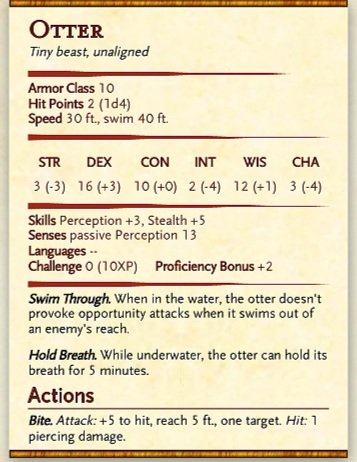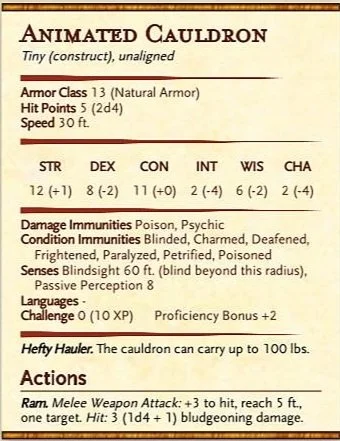Fun Familiars for 5e
Part 4 of The Life of Pets, Familiars and Animal Companions Series
The Life of Pets, Familiars and Animal Companions
Life of Pets II
Familiars in 5e
I've talked about familiars in previous articles. While I have my issues with the limitations of these creatures, what is a wizard without its familiar? Sure, they have been reduced to an out-of-combat opportunity to roleplay part of the game (The owl is the exception to the out-of-combat rule, thanks to its flyby ability). Still, a large majority of players playing a wizard will grab the spell immediately. I am currently playing a Pathfinder 2 campaign, and familiars are very different from those found in 5e. That's a tale for another time, but some loose influences are located in the familiars below.
Today, I wanted to look at a couple of familiars in my current game that isn't found on any list, along with a beast that, for some odd reason, doesn't have an official stat block.
Otter - I only know the otters I had seen in the zoo, the North American river otter, and the sea otter. Otters are a subfamily of the Mustelidae family, which includes the weasel, badger, and everyone's favorite superhero, the wolverine. There are 13 otter species in the Lutrinae subfamily, which include aquatic and semiaquatic types. For all intents and purposes, I used the sea otter as the basis of this familiar, but in reality, it makes very little difference.
The sea otter can be lightweight, weighing around 30 pounds, but can also fight in the heavyweight class in the Tiny creature classification as they can weigh up to 90 pounds. They mainly eat shellfish, and how they eat can be a violent scene to watch. After diving down and grabbing a clam, mollusk, crab, etc., the otter will swim over the shore and prepare its meal. They can hunt around for the tastiest-looking shell since these creatures can hold their breath for up to 5 minutes.
Otters carry a rock with them at all times, stored in a bit of pouch of loose skin across their chest. I try to picture it as a built-in bandolier, but it's probably closer to the front pocket on a dress shirt. Our friendly otter will take its rock, smash the shell till it breaks open, and then feast on the yummies inside. They don't mess around either, wailing away on the shell to get inside it. They apparently like their seafood tenderized.
Our familiar has two primary abilities of note. The first is their Dive ability. Like the owl, the otter will not provoke an attack of opportunity when it passes by an enemy. Why, you may ask? Well, two reasons. First, if you've seen an otter dive underwater, you'll know how incredibly quick they are. They could quickly dive underwater, swim underneath the baddies, and speed away before they ever knew what happened. Second, one of the cool things about otters is how they float on the backs. That may be just me, but it's neat watching them cruise around eating, cleaning themselves, or just basking in the sun. In my twisted imagination, I picture them doing the backstroke as they go by a sahuagin, sliding on by as they reach out a paw to deliver a spell.
The other ability is being able to hold their breath for 5 minutes. Other creatures can do this much longer, but 5 minutes in D&D is a lifetime. Our fuzzy little friend can do a lot of underwater scouting for you in 5 minutes. It's not a "wow" you ability but can have some use given the right setting and your imagination.
Dog - It boggles my mind that a man's (and woman's) best friend has no official stat block. Now you can find the blink dog, hellhound, and death dog in the Monster Manual, along with a few others in various books. But the everyday domesticated dog? There is a single stat block, which is for the Mastiff.
Now maybe this is because there are over 400 breeds of dogs, and they can vary in many ways. There are crossbreed and purebloods. The size of a dog can range from the tiny 3-pound chihuahua to the aforementioned massive 130-pound bullmastiff. There are 7 dog classes with the skills to match - hunting, herding, toy dogs, terrier, working, sporting, hound, and non-sporting. With so many dogs to choose from, maybe WotC got overwhelmed and thought, "Screw this. Let's just make 10 more types of demons".
To me, that's no excuse for not giving this unique creature its due. The domesticated dog is a descendant of the wolf, who, of course, has a stat block. The grey wolf is a distant cousin of the dog, and while our pup may not have much in common with a wolf in the present day, they do have their own unique set of skills. Through selective breeding, dogs have developed various behaviors, sensory capabilities, and physical attributes.
For this scenario, I've created a generic dog stat block for our furry four-legged friend. As I'm typing this, I think it would be fun the create a dog template, allowing you to create a stat block for your own breed. If you DM allows pets or familiar not found in the DMG, you could have a loyal companion that can bring more than the ability to sit and roll over to the campaign. Keep an eye on this in the future!
Our dog, being a simple but loveable creature, doesn't have any abilities that make it jump out at you, especially since it falls into the Tiny creature size. Keen Smell is relatively common but a must when talking about the dog. Its bite attack is nothing special, but once again, we aren't talking about a Great Dane here. Your dog familiar can understand common but obviously can't talk back. Besides, if they could, it would probably say feed me or pet me over and over again until you complied…or cast a silence spell.
Animated Cauldron - Our party's witch has this as her familiar, and it's fantastic. It runs around like a puppy, acts ferocious in one situation, and cowers behind her master in others. I know some people may have an issue with a construct being a familiar, but it's a fantasy game. Embrace the creativity of the people at your table…within reason, of course. Players do have a tendency to be a bit overzealous at times.
The primary ability that makes it unique is Hefty Hauler. At 1st level, you probably don't have a bag of holding to carry around your loot in. You won't be able to carry a 10 ft. tall marble statue in it. After all, the cauldron is a tiny creature. But you can use it as a vehicle to store other goodies such as gold, potions, and other mundane items. Having your cauldron run over to deliver a quiver of arrow or potion of healing is a whole lot safer than the wizard did it.
What else does our animated cauldron bring to the table? Well, it gets all the fun senses and immunities that other constructs do. It's immune to being Blinded, Charmed, Deafened, Frightened, Paralyzed, Petrified, Poisoned. If some mean kobold tries to poison it, or a mean old mind flayer tries to melt its nonexistent brain, they fail. Finally, it has Blindsight up to 60 ft, which can come in very handy in certain situations.
Want to have a stat block for a different familiar? Put it in the comments below, and I'll get one completed as soon as possible. If you like the familiar listed above and want a printer-friendly PDF of this, or any tool or subclass we've made, consider supporting us on Patreon! All homebrew that we've created or will create in the future will be uploaded to our Patreon in printer-friendly versions. We appreciate any and all support!
Like what we are doing here?
Support us on Patreon!
You'll get early access to deep dives, our Homebrew Hoard, Monster Thursdays, and more!
Follow us on Twitter to keep up to date on everything we talk about!






